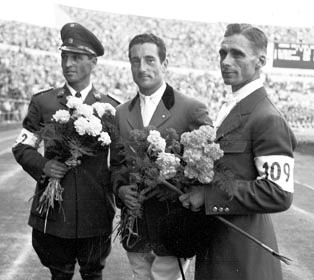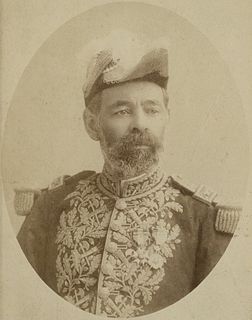 W
WJosé Luis Araneda Carrasco was a Chilean Army officer who fought in the War of the Pacific.
 W
WOrozimbo Barbosa was a Chilean politician and military figure who played a major role in the Occupation of the Araucanía (1861–1883), the War of the Pacific (1879–1883) and the Chilean Civil War (1891).
 W
WEmilio Bello Codesido was a Chilean lawyer, diplomat, deputy and President of the Government Junta that ruled Chile in 1925.
 W
WCesar Raúl Benavides was a Chilean Army general and member of the Government Junta that ruled Chile from 1973–1990. He served on the junta as a member from 1981–1985.
 W
WDivision General Juan Pablo Bennett Argandoña was a Chilean military officer and member of the Government Junta that ruled Chile between 1924 and 1925.
 W
WBartolomé Guillermo Blanche Espejo was a Chilean military officer and provisional president of Chile in 1932.
 W
WGeneral Jorge Boonen Rivera was a Chilean military officer and minister.
 W
WManuel Bulnes Pinto was a Chilean military and political figure.
 W
WEnrique Campino (1794–1874) was a Chilean politician and soldier who campaigned for his country's independence.
 W
WLieutenant General Julio Canessa Roberts was a Chilean military and political figure. He was a member of the Government Junta that ruled Chile from 1973 to 1990, representing the Army. He was also a designated Senator between 1998 and 2006.
 W
WEstanislao del Canto Arteaga was a Chilean military figure who played a major role in the War of the Pacific (1879-1883) and the Chilean Civil War (1891). He also participated in the Occupation of the Araucanía (1861-1883) and the Chincha Islands War (1864-1865).
 W
WVice Admiral Patricio Carvajal Prado, was a Chilean admiral, several times Minister and one of the principal leaders of the 1973 Chilean coup d'état that ousted President Salvador Allende.
 W
WJuan Emilio Cheyre Espinoza is a retired Chilean Army General. He was Commander-in-Chief of the Chilean Army from 2002 to 2006. As Commander-in-Chief he attempted to distance the Army from former dictator General Augusto Pinochet, and condemned the human rights abuses of Pinochet's dictatorship.
 W
WÓscar Cristi Gallo was a Chilean police officer and a successful show jumping rider from the late 1940s until the late 1960s.
 W
WGeneral José María de la Cruz Prieto was a Chilean soldier.
 W
WLuis Esteban Gómez Carreño was a Chilean naval officer. Having joined the navy aged 15 on board the Huáscar, he later served as squadron commander in chief, director of the Naval School and Minister of War and the Navy under the September Junta. He was involved in a car accident on one of the bends of the 'El Olivar' road between Quilpué and Viña del Mar on 1 January 1930 and died 5 days later. He is buried in Cemetery Number 2 in Valparaiso.
 W
WAlejandro Gorostiaga Orrego, was a Chilean military officer born in La Serena. He joined the Escuela Militar de Chile in 1857 till his retirement in 1878. Alejandro Gorostiaga was of Basque descent.
 W
WÓscar Izurieta Molina was a Chilean military man. Molina had the grade of General of the Army and was Commander in Chief of the Army of Chile from November 14, 1958 to November 3, 1964. He is the father of former commander in chief, General Oscar Izurieta Ferrer and was the first commander in chief who used the name of Army General as Commander in Chief. His father was Ricardo Izurieta Torres, a Spanish immigrant originally from Ortigosa de Cameros, La Rioja, Spain, who arrived in Chile during the first decade of the twentieth century.
Francisco Laso de la Vega y Alvarado (1568–1640) was a Spanish soldier who served as Royal Governor of Chile from December 1629 to May 1639. Victor in many battles against the Mapuche in the Arauco War.
 W
WJorge Lucar Figueroa was a Chilean Army general and member of the Government Junta that ruled Chile from 1973–1990. He served on the junta as a member from January 2 to March 11, 1990.
 W
WJorge Martínez Busch was a Chilean Navy admiral and member of the Government Junta that ruled Chile from 1973 to 1990. He served briefly as a member and the President the junta in 1990, after the retirement of admiral José Toribio Merino. He also served as the Commander-in-Chief of the Chilean Navy from 1990 until 1997.
Francisco de Meneses Brito was Royal Governor of Chile between 1664 and 1667.
Arturo Merino Benítez, was an aviator with rank of Commodore, and the founder of both the Chilean Air Force (1930) and LAN Chile (1929) the national airline. Chile's largest airport was named in his honour, Arturo Merino Benítez International Airport. His parents were Pedro Merino Feliú and Clorinda Benítez Labbé. He died from a stroke at age 82, his remains are at the Cementerio General de Santiago.
 W
WArturo Merino Núñez is the current commander-in-chief of the Chilean Air Force. He is the son of commodore Arturo Merino Benítez, founder of the Chilean Air Force (1930) and LAN-Chile (1929)
 W
WLuis Miqueles Caridi was commander in chief of the Chilean Army.
 W
WJulio Leiva Molina is the current commander-in-chief of the Chilean Navy.
 W
WVice Admiral Francisco Nef Jara was a Chilean naval officer and member of the Government Junta that ruled Chile between 1924 and 1925.
 W
WCandelaria Pérez was a Chilean soldier, who served in the War of the Confederation (1836–39) against the Peru–Bolivian Confederation. Initially, she was a cantinière, but she took up a rifle and fought alongside the men she served with. She was considered the hero of the Battle of Yungay, during which when she led an assault against the entrenched Confederate troops. She was given official recognition and the rank of sergeant after the battle.
 W
WGeneral Arturo Puga Osorio (1879–1970), was a Chilean military officer and Chairman of Government Junta in 1932.
 W
WEleuterio Ramírez Molina was a Chilean military figure. He founded the Foro Militar military newspaper in 1871.
 W
WDaniel Rebolledo Sepúlveda was a Chilean Army sergeant, who fought in the War of the Pacific.
 W
WEnrique Simpson Baeza was a Chilean Navy officer and explorer. Simpson mapped the archipelagoes and coast of Aysén Region onboard of the corvette Chacabuco in the 1870s. Among his feats is the re-discovery of San Rafael Lake and the insight that Aisén Fjord provides the best access to the interior of Patagonia from the Pacific.
 W
WSantiago Sinclair Oyaneder was a Chilean Army general and member of the Government Junta from 1988 to 1990 that ruled Chile from 1973–1990.
 W
WGeneral Rodolfo Stange Oelckers is a Chilean politician and former senator. He was a member of the Government Junta that ruled Chile during the dictatorship period from 1973 to 1990, representing the police force. He was elected Senator in 1998, finishing his term in 2005.
 W
WGregorio Urrutia was a Chilean military figure who played a major role in the later phase of the Occupation of Araucanía (1861–1883), leading Chilean forces that resisted and suppressed the Mapuche uprising of 1881.
 W
WJosé Velásquez Bórquez was a Chilean general best known for participating in the civil war of 1859 against the Conservative_Party_(Chile)#Opposition:_1851-1891 government of Manuel Montt. Later in life, Bórquez was elected to the Chilean Parliament.
 W
WFrancisco Vidal Gormaz was a Chilean naval officer and hydrographer who explored the coasts of Chile including some river systems and lakes. During the 1850s he explored and surveyed several times Maullín River with Francisco Hudson. Before being lost at sea in 1859 Hudson is thought to have been a major influence on Vidal Gormaz. He participated in the Occupation of the Araucanía performing reconnaissance missions in the coasts of Arauco and Toltén. In 1863, he was named director of the Maritime School of Ancud. In 1874, he became the first director of the newly created Hydrographic Office. In 1884, he became General Inspector of Lighthouses and participated in the International Meridian Conference. Because of his neutrality during the 1891 Chilean Civil War he was removed from his post as director of the Hydrographic Office. He was named assistant at the Sea Ministry in 1894 and retired from the navy in 1899.
 W
WPedro de Viscarra de la Barrera, twice Royal Governor of Chile, was an old lawyer who had arrived in the Captaincy General of Chile from Spain in 1590. Alonso de Sotomayor went to Peru on July 30, 1592 to petition the viceroy there for more men leaving Pedro de Viscarra with the title of lieutenant governor of Chile. Upon the arrival of Martín García Óñez de Loyola on 23 September 1592 to replace Sotomayor, Viscarra relinquished his office.
 W
WJosé Ignacio Zenteno del Pozo y Silva, was a Chilean soldier, politician and hero of the Chilean War of Independence.